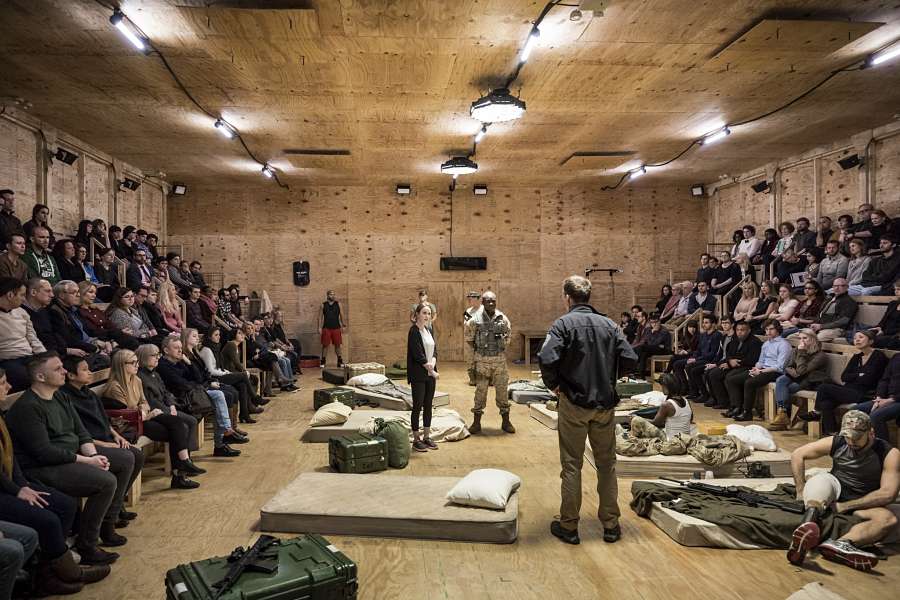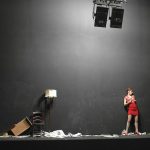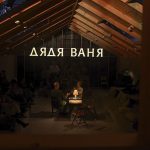These days there’s the unmistakable smell of fresh lumber at New York Theatre Workshop, the East Village Off-Broadway mainstay which seems recently to have abandoned any pretense of standard proscenium staging in favor of layouts custom-configured for each show. For every Lazarus and Red Speedo, which put audiences in the familiar arrangement of rows facing the stage, there’s an in-the-round Hadestown or an avenue-staged Nat Turner in Jerusalem—only the most recent examples of the space being treated essentially as a mutable black box.
The current occupant is a muscular, militarized new Othello, in a first-rate revival that pairs director Sam Gold with one of his most frequent collaborators, set designer Andrew Lieberman. The two have turned the space into a plywood box, modeled in part on the kind of temporary military installations that U.S. troops have mounted in deserts in Iraq and Afghanistan over the last dozen years or so, and put the audience on three sides of the action. They’ve also covered the theatre’s ceiling, radically restricting lighting designer Jane Cox’s options to practicals, LEDs, and assorted creative uses of work lights.
Lieberman, an inventive designer, doesn’t always mess up theatrical spaces this way, nor does Gold, a soft-spoken director known for his meticulous work with playwright Annie Baker and for notable forays onto Broadway (Fun Home, Seminar). With other directors, including Daniel Fish, Lieberman has been know to fashion memorable, only-in-the-theatre stage pictures, while Gold’s work with set designers David Zinn and Mimi Lien has been more notable for naturalistic detail than minimalist abstraction.
These two artists, who met in 2000 and have worked on several shows since, clearly bring out something in each other—a certain rigor and daring. In two 2012 New York productions, they set a high bar for severity: In a sere revival of John Osborne’s Look Back in Anger at Roundabout Theatre Company’s Laura Pels Theatre, they walled off the proscenium so that actors had to play on and off a narrow strip of stage against a concrete wall that might as well have been a stage-door alley. And for Annie Baker’s borderline mumblecore take on Uncle Vanya, Lieberman constructed a sort of attic rec room in an A frame house within Soho Rep, with the audience uncomfortably eavesdropping on the action.
Then last year they staged a revival of The Glass Menagerie at Ivo van Hove’s Toneelgroep Amsterdam that dispensed with the niceties of a set altogether—a conceptual stunt of a sort that, somewhat surprisingly, will come to Broadway in February, with Sally Field as Amanda.
As they explained to me in a recent interview on Othello‘s barrack-like seats, their collaborations have been about creating limitations—Lieberman calls them “parameters”—that put pressure on their work in challenging, often stimulating ways. In a free-ranging conversation, they talked about Shakespeare, about sets that aren’t sets, and about materials that cannot be betrayed.
ROB WEINERT-KENDT: When I think of your work together, I see in common a certain rawness, exposed construction, reconfigured spaces. Am I far off?
ANDREW LIEBERMAN: Well, the productions in a broad sense are focused on the actors and the actors’ relationship to the audience on a fundamental level.
SAM GOLD: Yeah, the word “intimacy” is probably more appropriate than “raw.” Putting the actors really close to the audience, putting the audience around it, putting the audience inside the event. So you’re inside this—you’re inside this box. And also the lights that hit the actors hit the audience, so it’s a shared, intimate space.
WEINERT-KENDT: It seems like you’re not just designing a set that lives on the stage, on the other side of the footlights—you’re designing the whole room for everyone in it, including the audience.
LIEBERMAN: Yeah, I would say I’m trying to figure out the right proximity of actor to audience.
GOLD: For Look Back in Anger we took the proscenium and closed it off, walled it up. We took the concrete and just continued it as if there was no stage, as if the stage didn’t exist. So the show happened in the audience in the auditorium. That decision to put the actors that close to the audience and in the same space is sort of the same gesture as here; you can put us all in the same space by making this box and putting people in it. In Uncle Vanya we sort of did a similar thing. Andrew is designing the audience’s space. Probably the bulk of your work for Othello was designing the seating.

LIEBERMAN: One of the things that’s working really well here, better than I expected or even thought about, is the relationship of the performers to the audience. And the audience is so much a part of a Shakespeare play. There’s a kind of connection of audience to performer that is direct and indirect in Shakespeare.
WEINERT-KENDT: I think I know what you mean about Shakespeare and the audience, but say more about that.
GOLD: I mean, those plays are made for such a direct relationship with the audience. There’s the soliloquies. But on top of the obvious aspect of talking to the audience, Shakespeare just wrote with a kind of really aggressive kind of irony. He wanted to the audience to be in relationship to the story in a very direct way. If you see Shakespeare in the Park, it’s like all the stuff is being pitched to the audience and the audience is responding. There’s a lot of call and response. There’s a lot of involvement.
In Othello it takes the form of this kind of dramatic irony, where the story is told to the audience by the antagonist, so they know before the other characters do what’s happening, and that makes the audience complicit. The play is really built on that. So you need a design that makes the directness of that relationship between Iago and the audience really specific. It wasn’t necessarily what we were focused on when we designed it, but it turns out to be a really successful aspect of this space.
WEINERT-KENDT: In regards to the playing spaces you need to create with Shakespeare, there’s a lot of strategic eavesdropping, and asides that only the audience or that certain characters are supposed to hear, and other characters are supposed to not hear. Can you talk about how this boxed-in space works for those?
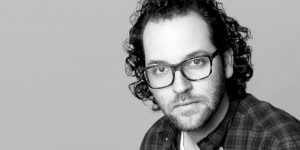
GOLD: There’s a bunch of that in Othello. It’s actually sort of the hardest thing for me to do, because my work is not theatrical like that. Those conceits aren’t what I do. Shakespeare is hard for me, because I like psychological realism and I like actors to be in a world where you don’t make excuses for it: “Oh, because it’s a play.” So there’s the scene in Othello where Iago’s trying to prove to Othello that Desdemona’s been cheating on him with Cassio, and he says, “Encave yourself over here,” while he questions Cassio. So Othello hides. For one, I’ve trimmed some of the asides to make it feel a little more realistic, and there’s a design conceit to that moment that has a lot to do with the world of this production.
WEINERT-KENDT: When you’re looking at problems like that, that you’re trying to solve staging-wise, do you look to a design solution?
GOLD: I look to Andrew as a co-director. I don’t even know if design is the thing we spend the most time talking about. We talk about the vibe of the production and how we want to relate to the actors and how we want the actors to relate to the audience, and how we want the play to move, what we want it to feel like. How it feels—that is our work, and it provides a certain amount of tools. And then we have to use them and see them through, and then maybe come to the specific design of the show.
LIEBERMAN: What I always find myself doing with Sam is trying to find ways to take what he’s doing, like specific work with actors, and connect it to the context we’ve created, and to constantly be the presence that says: Let’s find ways to connect everything to the larger ideas that have driven this production.
GOLD: Often our collaboration is that we take a pretty big and aggressive leap about the production when we start—like, walling off the whole proscenium of the Laura Pels Theatre for Look Back in Anger. Then in rehearsal, I get so seduced just by working with actors and thinking about their psychology and getting involved with the storytelling that I can kind of lose track of the muscularity of those decisions we made. Andrew can come and show me where those things could suture the staging moments together.
LIEBERMAN: Sometimes that’s a design choice, and sometimes that’s a blocking choice, and sometimes that’s a line reading.
WEINERT-KENDT: It strikes me that a lot of the choices you make necessarily involve building something long before anyone sets foot in it. But if you take these aggressive leaps of faith and make these strong decisions early on, what do you do if that starts to change once the actors arrive?
LIEBERMAN: You can’t change the overall conception, but you can change a lot. I mean, it’s the theatre, so on some level we can do whatever we want in here. If we wanted to suddenly do Hello Dolly! we could probably do it in here.
GOLD: We might paint it.
LIEBERMAN: It’s surprisingly malleable. But I do think Sam and I give ourselves kind of a limited palette. It can be frustrating at times. It’s kind of a perverse exercise of taking away all the theatrical tools that you normally have at your disposal to solve a problem: If you need to isolate somebody, you just put them in a spotlight and you’re done. But when all the actors are onstage and the whole room is lit up and you don’t have any lights that don’t just light up the whole, how do we solve that? It can be very challenging.
GOLD: Yeah, what our relationship is based on a lot is making these aggressive choices that make my life really fucking hard. And then I whine at Andrew a lot that he made an impossible set, and I hate it, and I wish I just had some things that made my life easier. And then he reminds me that I always whine like this and that we always come out okay in the end.
LIEBERMAN: Also I think Sam does his best work when he’s most annoyed.
GOLD: At you. Most annoyed at you. Not in general.
LIEBERMAN: Yeah, when I make his life the most difficult. But then again, I don’t just make it difficult and then leave. I’m around.
WEINERT-KENDT: So give me an example—of something he built for Othello, where you were like, “I wish I had something different here.”
GOLD: I could tell you a million things, but one thing that comes to mind is when you enter the beginning of the show there’s a mattress on the floor for every actor. The idea is that the whole cast comes in and they go to bed at the top of the show, so the play is this nightmare that takes place in their minds when they go to sleep in this warzone. That’s the idea. But when you put down 12 beds in this space, it takes up all the real estate, and it’s impossible to stage the play because there’s nowhere to stand and there’s nowhere to sit and there’s nowhere to move. You’re doing Shakespeare lying in bed. It was the idea: We were like, “What if you could do a Shakespeare play lying in bed? Wouldn’t that be great?”

It was great when he and I had that idea. But then I have to get into a room and have an actor being like, “I’ve just learned that my daughter has abandoned me and married a man behind my back and I’m going to kill myself, and I would like to walk three feet stage right and express myself.” And I’m like, “Well, you can’t, because there’s a mattress in your way and you’re going to step on it.” It’s not easy for sightlines and staging and you have audience on three sides.
When it’s a thrust like this, you have to keep actors moving. Staging becomes very abstract in the round, because you have to move more than you do in real life. But I have very little motivating them moving. Usually when you design a thrust, the other thing you do—if you’re not a sadistic set designer—is you design the idea of what’s going to make them move. The design tends to help you move people in a thrust or in a round. But we’ve been doing these shows where it’s on me to figure that out in a space that doesn’t lend itself to that.
Hopefully what Andrew and I have done with this, and with Vanya, is that it doesn’t feel like a play because of that. You feel like you’re observing life in a way that doesn’t remind you of the stage so much. And I don’t think this is much of a stage. It’s this little box that we hang out in and people lie in bed and it just feels a little different.
WEINERT-KENDT: The funny paradox about all the conventional effects in most theatre is that they can make you feel like you’re looking at something real—they can sort of lull you. But if you’re just looking at people in a room with just average lights on, as you are here, you’re actually very conscious that you’re in a room with these people. It’s a different kind of theatricality.
GOLD: That’s right. You’re confronted by it. You don’t just take it for granted the way you do most plays. So that is theatrical in some sense of the word. You could also call it anti-theatrical, though.
LIEBERMAN: It’s kind of anti-theatrical.
WEINERT-KENDT: You’ve worked a lot together, as well as with many other folks. Andrew, is there a certain thing you know you’re up for when you’re working with Sam?
LIEBERMAN: Well, I sort of know it’s not going to be about the design. It’s not going to be decorative. It’s not going to be about the design solving the dramaturgy of the play. It’s going to be about the actors—the actor as the starting point.
WEINERT-KENDT: And that doesn’t characterize all of your work?
LIEBERMAN: I wouldn’t say so. I may have other things I work on with other people—I also do a lot of opera, which is a totally other thing. It’s funny, we were joking when we did The Glass Menagerie, which really has no set, I was like, “I’m just writing myself out of a job. What is the point? What am I doing here?” And I have sort of thought that maybe we’ve reached the pinnacle of that, and maybe it’ll start swinging the other way.
GOLD: It’s going to have to swing in the other direction.
LIEBERMAN: You know, how long can you just keep doing nothing?
GOLD: It’s really just the empty theatre.
LIEBERMAN: And it’s been interesting bringing it to Broadway, because if you were originating a production on Broadway it’s kind of the opposite of what you would imagine doing. I keep having these meetings with people to explain the set, and there’s just this look on people’s faces like, “Really? There’s nothing—there’s nothing here. This isn’t a show. This isn’t entertainment.” But I’m just forging on.
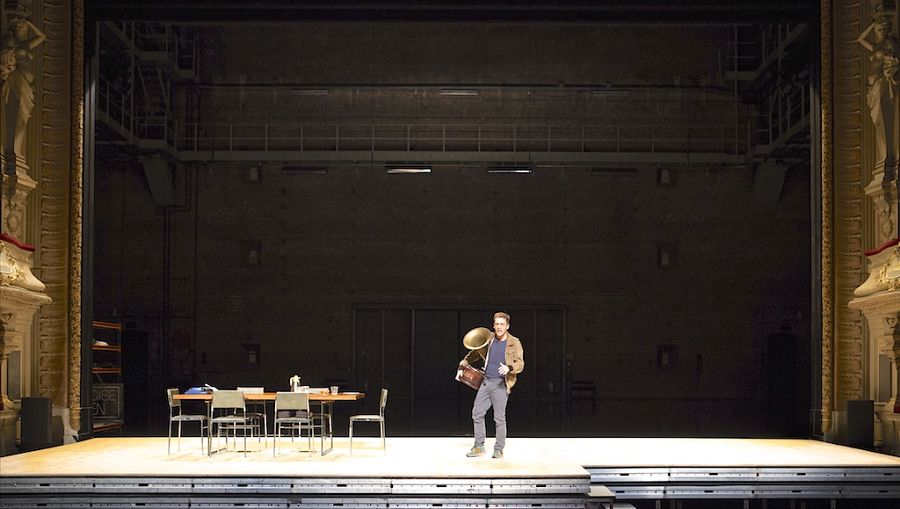
GOLD: Part of that, coming back to this thing about him making it hard for me and then me getting whiny, is that then the pressure is on—I better make the work with the actors really good, because I don’t have anything else. I have nothing else other than four people on an empty stage doing Tennessee Williams, which you just saw three seasons ago on Broadway. So what Andrew is saying is that I work well under than pressure.
WEINERT-KENDT: I’m intrigued by the idea of a maximally minimal set design, and how insisting on there being no set must be a kind of a full-time job for you—to hold the line on that vision.
LIEBERMAN: My job is just to put the focus on the actor.
GOLD: There are a ton of choices that go into no set. He worked really hard on that no set. It’s a million decisions. It’s just that you’re not going to see it.
WEINERT-KENDT: Sam, what’s different about working with Andrew as opposed to other designers you work with?
GOLD: I’d say that Andrew is very rigorous about materials that cannot be betrayed. There’s a kind of a set of rules that come with the space, and you’re not allowed to break those rules, and the materials are what those rules are about. So The Glass Menagerie has no set, and those materials make its not-set-ness. And those materials are important and cannot be betrayed.
LIEBERMAN: I’m big into parameters. It can be different parameters for different productions. I feel sometimes that if you let all the designers have free rein to do all the things they could do, then you end up with just a kind of smorgasbord of choices, and there’s nothing forcing your hand to really make you solve a problem. There’s always some way you can solve it, whether or not it’s aesthetically consistent or dramaturgically consistent. So I’m like—I’m a big fan of parameters.
GOLD: And it’s exciting I think for the audience to see the way a team solves a problem. It gives birth to something onstage that we find aesthetically interesting.
LIEBERMAN: Like in this show, one big parameter is to take away the ceiling. Suddenly the lighting designer doesn’t have their tools. Right? So that’s a big parameter. Then you have the actors in a box where you can hear a pin drop. The classic thing people say about Shakespeare is that if you can’t see their faces, you can’t understand them. And there are huge stretches of this show where you can’t see the actors or their faces, and they’re whispering. I don’t know about you, but not one person has said anything about how half the show’s in the dark and that they can’t hear it. Which kind of means that all those choices are going hand in hand and that they’re working. On a different kind of show, it would be intolerable what we’re doing.
GOLD: If it was this dark with this few lights, and it wasn’t this intimate with this kind of space, it could really fail. The parameters have to work.
WEINERT-KENDT: Your talking about acoustics makes me wonder, Andrew: How much of your thinking is architectural as opposed to presentational?
LIEBERMAN: It’s almost all architectural. Because I do a lot of opera, where there is a huge emphasis on acoustics, opera producers are always looking to set designer to solve the acoustical problems of the opera house. A lot of opera houses have huge acoustical problems, many of them, and they need certain things. So I’ve just been inadvertently trained over the years to know what—I’m not an acoustician, but I know what helps and what doesn’t. So everyone was saying this space was going to be really echoey, and I was like, “Actually, the space is going to be really good—you’re going to be able to hear really well in here.” That goes back to the humanizing thing, because I want Sam to be able to let his actors talk at this conversational volume.
GOLD: And in this space the audience becomes the acoustic masking that dampens the echoey-ness of the plywood. You couldn’t have a plywood box and hear Shakespeare in it if one side of it wasn’t soft. The bouncing has to stop somewhere. In here it stops on the audience.
WEINERT-KENDT: So this is all plywood, as far as the eye can see?
GOLD: 500 sheets.
LIEBERMAN: The set comes very specifically from some military architecture we looked at. It’s funny, it inadvertently became a theatre. We didn’t start out with the idea of being a theatre. We looked at these forward operating bases.
GOLD: These kind of semi-improvised little plywood forward operating bases. This structure is really exactly what these things look like.
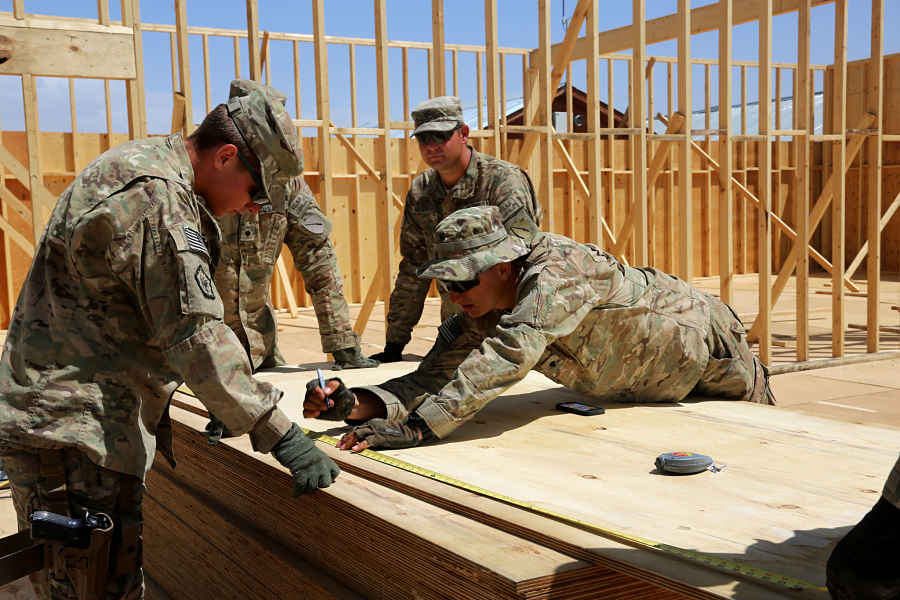
LIEBERMAN: And, you know, if I had my way, it would probably be more improvised-looking, but when you have to get 200 people safely in and out, then it starts to get a little more organized.
WEINERT-KENDT: So are these seats actually modeled on cots?
LIEBERMAN: No, they’re modeled on a sweet spot of people being comfortable for three hours and it looking like a kind of somewhat improvised military temporary seating installation. After Uncle Vanya, which was not high on the comfort list…
GOLD: We said to each other, “If we’re going to do this again, it needs to be more comfortable, because people are going to get sick of us if we keep putting people in these spaces and their legs fall asleep again.”
LIEBERMAN: So we worked pretty hard on it. We made mockups. We had producers sit in them. A lot of thought went into it. It’s a really hard thing to get right. The ergonomics of a chair are a hard thing to get right, and there are so many regulations. You really want this seat to be deeper, but it can’t be because you have to leave the aisle width, you know, a certain aisle width. And you don’t have a lot of money, so you have to work it out.
WEINERT-KENDT: On one level it’s crazy to be talking about redesigning theatre seats. Talk about reinventing the wheel. But I get it—in a piece this intimate, everything matters, nothing can be taken for granted.
GOLD: I think what Andrew and I want to do is make every choice specific to the show. You don’t just want to inherit things because they happen to be there. You want the show to dictate everything.
WEINERT-KENDT: Speaking of things that are inherited, this is your first professional Shakespeare, right, Sam? Can you talk a little about that?
GOLD: We did a Marlowe play when I was in school, and I’ve never felt far away from those texts. That’s the stuff that got me interested in doing theatre. I’ve always cared about those plays. But I think I’ve been spending so many years doing contemporary plays, and by definition contemporary American plays devalue language, because our culture is much more interested in subtext than text. So the plays that I direct mostly are very subtextual, and not particularly interested in what the words do. They’re much more interested in what the subtext does. And I had just been itching to get back to some plays that were about the language, and I wanted to do a better job at that.
I think I had done a couple things where I wasn’t happy with my work because I had been so interested in subtext that I wasn’t thinking about language enough. And this has been, for me, about really seeing how what I like to do with actors and design and event, how that could match the muscularity and abstractness of Shakespeare’s language. Could my interest and Shakespeare’s language work together? We had to meet each other halfway a little bit, and that’s what this production has been wrestling with.
WEINERT-KENDT: Andrew, you’ve done on a number of Shakespeare productions. What was your role in relation to Sam?
LIEBERMAN: I think I was here to reassure him that I believe that his sensibilities as a director, and the way he works with the actors, could work in a Shakespeare text. And then also to help him find ways to make that work.
WEINERT-KENDT: Certainly doing musicals, like Fun Home—that’s a language outside of naturalism.
GOLD: The abstraction of music is much closer to the abstraction of Shakespeare than a contemporary play. This production feels much more like doing a musical than any of the plays I’ve done lately. But there’s something different about it because it is talking. Talking is different than singing in its relationship to psychology and subtext and emotional life and conflict. And with the way I work on those things with actors, those become very particular questions in Shakespeare, because that language is abstract and has rules and is not natural, and how to approach to the poetry of that is different than music.
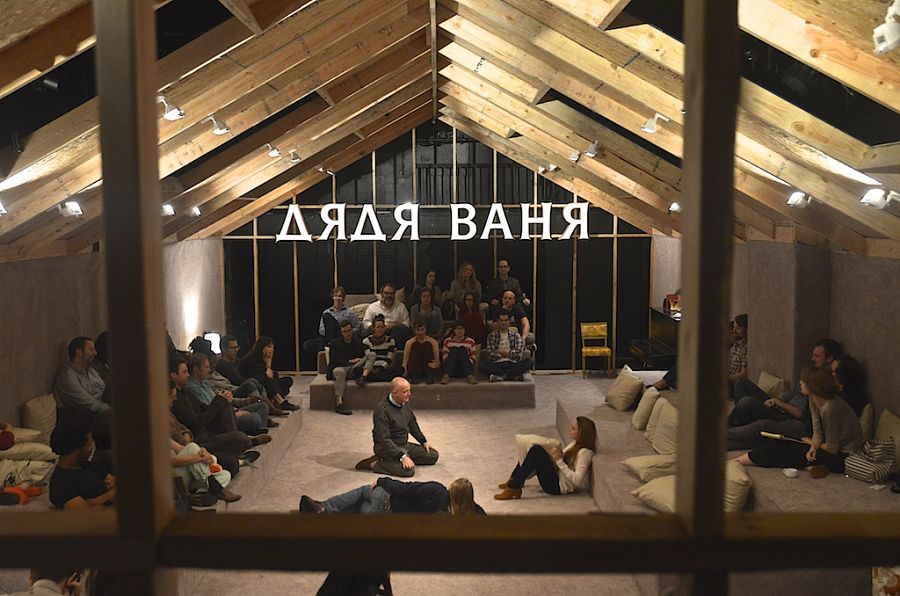
WEINERT-KENDT: I just had one question about Vanya, since we’re talking. What happened to all the furniture after intermission? Why did it go away?
GOLD: I wouldn’t have remembered we did that if you didn’t bring it up.
WEINERT-KENDT: They were all sitting on the floor; all the chairs were gone.
GOLD: There’s three acts to that show, so the furniture was set up differently in each act.
WEINERT-KENDT: But it was just suddenly gone, like it had been repossessed or something.
LIEBERMAN: Because it looked good.
GOLD: Yeah, I think it was more emotional than literal. But I don’t really remember. I’m sure we had a very good explanation at the time.

